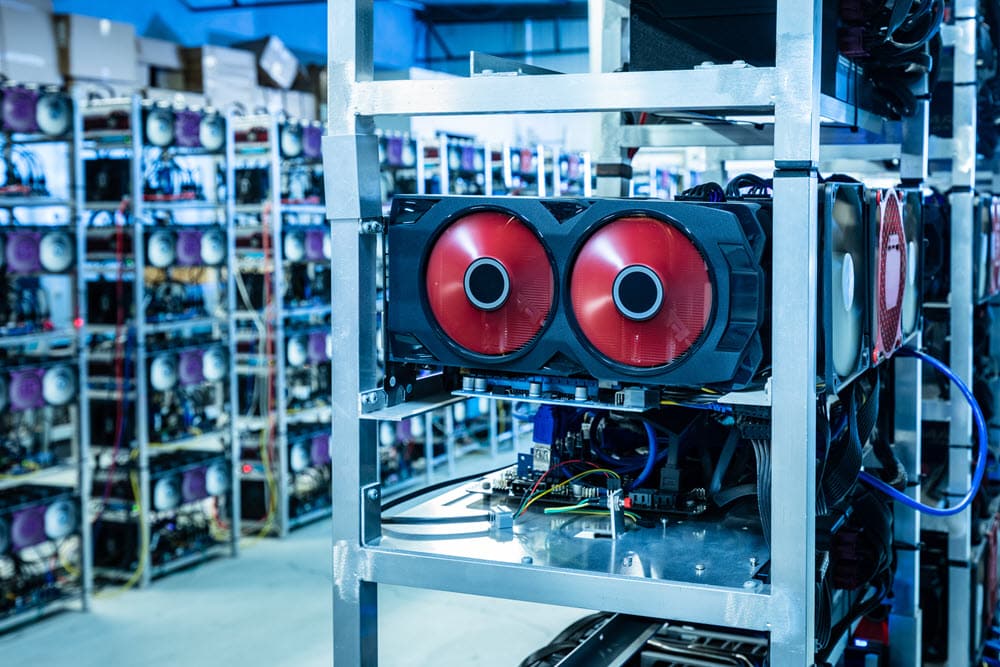This is Part 2 of a two-part investigation of cryptocurrencies. To read Part 1, go here.

Dedicated Bitcoin Mining Operations Are a Lucrative Yet Energy Intensive Industry
With Bitcoins currently trading somewhere between $57,000 and $64,000, there is a big financial incentive for potential “miners” to jump in and try their hand at earning Bitcoins.
But Bitcoin mining does not come for free. Successful mining operations depend on fast computer hardware and lots of electricity to perform the “proof of work” required to compete against other miners on the network to “win” the next available set of 6.25 Bitcoins that the system puts up for grabs every ten minutes or so.
While many so-called casual miners elect to turn on the mining function in their Bitcoin control panel and hope for the best, professional Bitcoin mining operators first make a careful assessment of their return-on-investment before jumping in, to ensure that the statistical chance of winning Bitcoins (and profits earned) exceeds the high cost of electricity and computer hardware needed to run a successful crypto mining farm at scale.
That’s why many large-scale operations (often described as the size of airplane hangars jammed to the gills with networked computers) are typically located in geographical areas with low-cost energy sources, places that traditionally attract energy-intensive industries, such as aluminum smelting.
Iceland, with its renewable hydroelectric and geothermal power sources, fits the bill, and as recently as four years ago, nearly 8% of the world’s large-scale Bitcoin mining operators were based there. But over the last four years, China has emerged as the dominant country for Bitcoin mining; it’s now estimated to be home to 70% of the world’s large-scale Bitcoin miners.
As we discussed in part 1 of this article series, what makes Bitcoin mining’s high energy use especially egregious is that it doesn’t provide any useful work (outside of earning coins). Bitcoin doesn’t help astronomers look for asteroids that could impact the earth, it doesn’t help identify useful drugs that could fight infectious diseases; neither does it help train AI systems to converse in other languages, nor can it help teach self-driving vehicles to recognize bicyclists or pedestrians crossing the road.
Adding insult to injury, the annual energy used by Bitcoin mining is staggering. Cambridge University researchers estimate that worldwide Bitcoin mining operations consume just north of 115 terawatt-hours (TWh) of electricity, and that a single Bitcoin transaction uses as much energy as 680,000 credit card transactions or more than 51,000 hours of watching YouTube.
Chinese researchers writing in Nature report that their research indicates that by 2024, Bitcoin mining operations in China alone will exceed the entire annual greenhouse gas emissions output of entire mid-sized European countries, such as Italy or the Czech Republic.
Countries that have made commitments to reduce greenhouse gas emissions have taken notice, and we can expect to see governments around the world respond in the near future. China may be the first to have done so, as the Chinese government reportedly recently shut down Bitcoin mining operations in the province of Inner Mongolia (which had been the home to an estimated 8% of Bitcoin mining activity) – but it’s unclear at this point if this action is more about saving energy or exerting Chinese political control over Inner Mongolia.
Mining a New Bitcoin is a Matter of Luck, But Luck Favors the Powerful Computing Systems
But high energy bills are not the only big expense for Bitcoin mining operators.

As we mentioned above, these operations employ LOTS of computer hardware because, when it comes to mining Bitcoins, earning new coins is essentially a game of chance, and the faster (and more often) you can roll the dice, the better your chances of scoring a win.
Increasing the number of computers helps, but so too does investing in powerful computing hardware that’s specially tuned to perform the mathematical operations required to “roll the dice.”
(For Bitcoin, that happens to be calculating a 256 bit SHA hash algorithm, a process colloquially known as “hashing,” but don’t worry — we’ll dive into the technical details shortly.)
At first, Bitcoin miners turned to high-end graphics processing unit (GPU) cards from manufacturers, such as Austin-based Nvidia, to crunch through numbers at a faster rate than ordinary computer setups relying on standard issue Central Processing Units (CPUs).
(One side effect of this was that gamers who rely on fast GPU cards to play video games found themselves in a bidding war with Bitcoin miners, which drove up the GPU hardware prices significantly.)
Most casual Bitcoin miners continue to use GPU-based systems, but, in recent years, professional Bitcoin miners have invested in custom silicon hardware tailored to the specific currency they are mining.
These boards, known as ASICs (short for Application-Specific Integrated Circuits), are highly optimized to blaze through Bitcoin hashing operations, as well as some (but not all) of the other cyber coin types that use a proof-of-work algorithm. (For example, no ASIC is currently available for Etherium, though one is planned for introduction later in 2021). There is also pushback from coin developers (other than Bitcoin) who are actively adjusting their algorithms to prevent an ASICs arms race from making their mining operations too exclusive, e.g. viable only to those with the most expensive gear.

Why Does Bitcoin use Mining Operations to Create New Coins?
Let’s back up and ask the big picture question. Why does Bitcoin use the mining operations in the first place?
At first glance, you might think mining for coins is a clever way to issue and distribute new cyber currency within a permissionless system, e.g. one that does not rely on a bank authority to issue new currency
And that is one reason, but not the only one.
The mining process also helps solve another even more challenging problem, known to computer science and math experts as the Byzantine General’s Dilemma, which describes a scenario where decisive action must be taken quickly (to win a battle), despite having to rely on potentially imperfect or unreliable information.
In the computer systems realm, the term is used to describe the challenge of achieving rapid consensus between a bunch of different inputs, any one of which might be unreliable (whether due to a piece of computer hardware that fails intermittently, a bad data connection, or a malevolent actor hacking into the system to steal data or wreak other havoc.)
In response, developers seek to create what’s known as a Byzantine fault tolerant solution (BFT) that continues to operate – even if some of the inputs are incorrect.
For example, one of the first aircraft to address this issue, the Boeing 777, evaluates each of its sensor and computer inputs when making automated split-second decisions about managing its flight controls, engine power, etc.
In the case of Bitcoin, the challenge is how to design the system to achieve consensus on the accuracy of the transactions – and avoid fraud.
For example, at any point, multiple computer nodes on the network could claim to have received payments into their account. But which transactions are real, which ones are suspect, and which transactions should be evaluated first?
Without a live human administrator validating transactions, the Bitcoin system has to make these decisions on its own.
How Creating a New Block in the Bitcoin Blockchain Releases New Coins to the Winner
To see how this works in practice, let’s walk through an individual Bitcoin transaction.
The first thing to understand is that while some users on the network (known as “full node” users) want to keep track of every Bitcoin transaction all the way back to the original “genesis” block, it’s not a very practical option for casual or mobile users.
For example, it would frustrate a new user attempting to use Bitcoin for the first time to download and crunch through all the Bitcoin transactions since 2009, which could overwhelm a smartphone-based Bitcoin app.
So instead, much like your checking account at the bank, Bitcoin regularly closes out historical transactions, encapsulating those records into a “block” in the ledger. These reconciled “blocks” of transactions create the definitive historical record of all Bitcoin transactions and collectively are referred to as the “blockchain,” which is a term you’ve probably heard many times before, even if you didn’t know its underlying meaning.
The blockchain approach frees up Bitcoin computer resources to focus on reconciling new transactions. Your bank uses a similar approach for checking accounts — once a monthly statement is issued, the resulting balance is carried forward to the next month so the bank can focus on reconciling new deposits and withdrawals.
Armed with this background information, let’s step through the process of making a Bitcoin transaction.
Our Bitcoin user Alan has a Bitcoin account (called a wallet) that is protected with a long account number and a very hard-to-guess password that the Bitcoin system generated for him.
TIP: It’s important to note that both experienced and newbie Bitcoin users have been tripped up by losing their account credentials. Without the correct password, a Bitcoin account is locked, and any funds inside the wallet are inaccessible forever!
Alan decides to spend 0.001 Bitcoin (roughly $60) by transferring it to another user’s Bitcoin wallet.
To make this happen, Alan’s Bitcoin software translates his request into an encrypted code based on his account number and his secret password, the amount to be transferred, and the destination wallet, e.g. account number of the payee.
The code that’s sent out never transmits Alan’s password, which remains a secret. But thanks to clever Private Key privacy methods, other users reading the code can verify that Alan has a valid password that matches his account number. They can also see a timestamp of the request, the amount to be transferred exists in his account, and the destination account.
What happens next?
Alan’s request is uploaded to the Bitcoin network, where it joins other transactions that are waiting their turn to be confirmed. (Sometimes Alan will have to wait a bit, sometimes up to an hour or more, if there is a queue of transactions ahead of him.)
As the transaction requests come in, computers that have opted in to participate in Bitcoin mining operations rush to assemble a set of them into a small group of proposed transactions, which, if selected, will become the next Block in the Blockchain ledger, earning them 6.25 Bitcoins for their effort.
But how does the Bitcoin system determine which computer to trust?
As you might recognize, we are back to the Byzantine General’s Dilemma.
We need to avoid honest errors (due to a garbled request caused by a bad data connection) or outright fraud (such as a bad actor attempting to hack into the system and transfer the Bitcoin into their own account).
To solve the problem, Bitcoin offers 6.25 shiny new Bitcoins as payment to the first computer on the network can do the following:
- Assemble a new proposed set of transactions for the next block.
- Perform a proof-of-work by running the proposed block’s transaction information – plus an additional random number appended at the end (called the nonce) through an SHA 256 hash algorithm.
- Check if the resulting hashed number is smaller than a target number set by the Bitcoin system.Winning numbers typically have 5 or more leading zeros. The exact number of leading zeros required is adjusted up or down by the Bitcoin system to make the process easier (e.g. faster) or harder (e.g. slower) to maintain an average cycle time of about 10 minutes between approving each new block in the blockchain.
- If the computer was not successful in creating a number smaller than the target, it tries again with a different appended number (the nonce). This is where a massive network of powerful computers comes into play; they can crunch through different appended number combinations faster, giving them a better chance to be the first to come up with the right hashed number combination that’s smaller than the target number.
NOTE: If a mining computer still can’t achieve a number with enough leading zeros, it can start over by updating the time stamp and/or choose a different set of pending bitcoin transactions to assemble into a new block.
Once a computer comes up with a winning number, it’s distributed around the network so other computers can confirm that the hashed number and the transactions in the proposed new block are legitimate (including Alan’s transfer request and a transfer of 6.25* new coins to the winning computer).
Once a majority of computers on the network agree, consensus is achieved, and Alan’s Bitcoin transfer (along with the other transactions in this round) is completed and recorded in the newest Bitcoin Block.
*At the beginning, 50 Bitcoins were issued for each successful blockchain transaction. But after every 210,000 blocks are mined, the number of Bitcoin issued is reduced in half (a process known as Bitcoin Halving). In 2020 the rate dropped to 6.25 coins. The next halving is anticipated sometime in 2024.

Forking Bitcoin’s Open Source Software Code to Create New “Altcoin” Currencies and Other Cryptocurrency Projects
As we talked about in Part 1, there are now quite a few “competitors” to Bitcoin, which are collectively known as the Altcoins.
In recent weeks, one of the largest Altcoin platforms, Etherium, has leaped into prominence, with traders pushing up its “Ether” coin values to $3,000. Its market share, now estimated at 15%, is growing quickly, while Bitcoin’s share has dropped from around 70% earlier this year to around 45%.
Meanwhile, Dogecoin, the cryptocurrency that’s widely considered to have been created as an absurd joke, continues to rise in value; it’s now reached $40 billion in market cap.
And Tether, one of the so-called stablecoins that supposedly has its value tied to the USD dollar, has reportedly grown to $50 billion in circulation.
Even Facebook is looking to get into the act. It’s been a while since Facebook first announced its Libra cryptocurrency and Calibra wallet projects – apparently, there has been some turmoil as several original digital currency founders and partners MasterCard and Visa partners have left the project.
The project is still happening according to announcements Facebook made in an earning call; however, the go-to-market names have changed – the new cryptocurrency will be called Diem (as in Carpe Diem?), and the wallet system is reported to be called Novi.
How was it possible for so many of these so-called Altcoins to come into existence?
In many cases, the answer lies in the open-source code licensing agreements used by Bitcoin, which allows for the code to be copied and modified (or “forked” in programmer’s terms) to create new derivative products (as long as they are also themselves open source.)
One caveat worth noting: In Part 1 of this article series, we mentioned that Australian computer scientist Craig Wright has claimed copyright ownership of the original Bitcoin whitepaper – but it remains to be seen what effect a copyright claim, if established, would have on existing Altcoin products. And it’s not clear that such a copyright claim would translate into an enforceable patent, but stranger things have happened.
If you can’t Beat Them, Join Them: Governments Make Plans for Issuing their Own Cryptocurrencies
Given the excitement and increasing market activity of digital currencies, it’s not surprising that national governments are taking notice.

What might be surprising is how long it’s taken.
Most western nations have taken a surprisingly noblesse oblige approach to cryptocurrencies, despite long having witnessed many potential reasons to crack down, ranging from the use of digital currencies to fund illegal product sales and activities, such as illicit drugs on the Silk Road website, to ransomware requests by hackers taking over computer systems.
But things are starting to change.
As the value of cryptocurrency holdings increase, so too does the interest of financial regulators and taxing authorities.
For example, you might have noticed that IRS now asks taxpayers filing a 1040 tax form to answer a series of questions regarding any virtual currency holdings they may have in order to identify any taxable income or capital gains.
But perhaps more important over the long haul are new signs of interest by central bank authorities around the world in creating their own versions of digital currencies.
For example, the UK’s finance minister Rishi Sunak (known as the Chancellor of the Exchequer) announced at the UK FinTech Week conference that he has asked the Bank of England to consider the possibility of a new central bank-backed digital currency (CBDC), a proposal the press has dubbed “Britcoin.”
If successful, a Britcoin backed by British Sterling could avoid some of the value speculation challenges facing other cryptocurrencies, such as Bitcoin and Etherium.
But many questions remain to be answered, such as how the new digital currency might impact financial trades that earn a small fee on each transaction – a digital currency run by the Bank of England might be able to capture these types of transaction fees instead.
Finance professionals around the world are also monitoring the recent indications that China is also considering issuing its own digital currency to operate alongside the paper Yuan currency.
There are reports that the Chinese bank wants to launch the new “electronic Yuan” in advance of the 2022 Beijing Winter Olympics.
Should the world’s economic leaders panic?
Could a first-mover advantage help pave the way for the Chinese currency to replace the US Dollar as the world’s reserve currency?
The Editorial Board of Bloomberg says not to worry, competition is good for everyone.
All we can be sure of is that cryptocurrencies will be a hot topic of conversation for the foreseeable future, for better or for worse.

Make Your Move with Efficient Work Environments from Formaspace
Whether you are building a new crypto-mining operation or updating your IT existing operations, Formaspace can help.
We build custom work environments, from ergonomic workstations and seating used in IT office environments to advanced industrial furniture solutions for operating large-scale electronic manufacturing, maintenance, and data processing operations.
If you can imagine it, we can build it, here at our Austin, Texas, factory headquarters.
Contact your Formaspace Design Consultant today, and find out why clients such as Apple, Capital One’s fintech division, Dell Computer, Google, Oculus, SpaceX, and Twitter choose Formaspace for their custom furniture needs.











